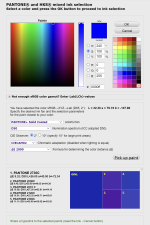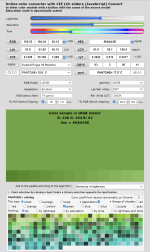I really appreciate the explanation of the motivations/designs behind SMS colors. Also, the idea that you started
selecting the colors of your system based on the likelihood of success in print reproduction seems brilliant
and wise. I hope you wouldn't mind a different perspective on color management as to why LAB values
would be better than the approach you explained.
Assuming most of SMS' targeted designers are using either the Adobe or Affinity design applications,
LAB values conveyed in ASE files are the best way to assure those designers have a path to excellent
print reproduction for their creations. For printers using RIP software, CGATS files and/or ICC named
color profiles consisting of LAB values are the best way to assure proper print performance. Some RIPs
(like Ergosoft) support importing ASE files with LAB values.
LAB color is device independent, and assures a standard for output. With respect, I think it is a bit of a backward
approach to convert an SRGB color space profile/RGB number into a LAB number that should have been
the basis of specification in the first place. Pantone as of a few years ago finally began to publicly disclose and specify their decks in
LAB. Another example of this approach is that EFI Fiery RIP distributes ICC named color profiles using LAB values
to specify Pantone colors in its RIP.
The reason I mentioned spectral values as another aspect of how SMS colors should be specified
is that anyone who might want to have paints and/or inks created would find that very useful.
I think you can better achieve your goal of a color collection that is more effectively print reproducible
using device independent LAB as the basis of specification.
Hey again, thank you for your comments, which are absolutely (pun intended) appreciated.
The Spot Matching System is a LAB based colour palette and it is always possible for users to get the LAB value of their colour(s). I have gotten quite a lot of comments concerning the spectral value part and that is in consideration. However since SMS colours are fixed to certain colour gamuts (sRGB, Rec. 709, Fogra and GRACoL CMYK gamuts, all of which are built and based on certain illumination and viewing angles, they are not intended to be judged with non-standard/custom lighting or viewing angles. At the same time it is always easy to take an SMS colour and use the LAB value of the colour to produce, - say a paint or a spot colour where you just need to define the target illumination and viewing angle for a visual match. I believe this should be possible using most modern colour mixing software where you have the spectral data of each colorant in the database.
The reason why it is not enough just to issue the LAB values of the SMS colours (besides from the fact that SMS is a business) and leave it at that is the fact that most designers and regretfully many Printers as well are not at all interested nor properly versed in colour management and constantly pressed for time and since it is now common practice that designers and other print customers are typically instructed to work in RGB mode and "just" deliver their PDF's in RGB (Adobe RGB usually) to their printer for late binding, who will convert the job to the destination CMYK output, usually using either relative colorimetric rendering intent or sometimes Perceptual when they convert from RGB to CMYK (depending on the printer), that will mean that the final CMYK composition of any SMS colours that might be used within the document (in RGB format) will be subject to chance. That is why SMS colours for print are at the moment delivered in CMYK format when it is clear what icc profile is appropriate - based on information from the printer responsible for printing the job.
I am sure you are aware of the current state of the art when it comes to brand colours - and how incredibly large colour fluctuations can be in reproduction of brand colours - even from one printer to the next, not speaking of colour fluctuations from one substrate type to another (from coated paper to uncoated paper) and especially from one media to another - say from print to Television or web. This is even the sad truth in the case of major companies like Coca Cola that should have a budget to at least standardize it's own brand colours cross media.
When our grandchildren look back on this time, they will most likely refer to the brand colour management of our times as the wild, wild west, where everyone is just focused on making any brand colour "pop" or look "pleasing to the eye", never taking into account that multi national companies and their brand colours travel around the globe for everyone to see - including colour fluctuations of up to a DE2000 of 15 in some cases.
At this moment in time I honestly think that it is best to do this one step at the time - by first making sure that the brand colours designers work with are reproducible in standardized CMYK printing to ISO standards. Step 2 is to check to what standards their printer(s) can in fact print - again to which ISO standards (Fogra or GRACoL/G7) and once that is clear, to make sure that they select papertypes that are appropriate and in accordance with the print standards available by their printers. Last step is then to manually provide the designer with their chosen SMS colours in CMYK format suited for using when they are setting up a job using the CMYK icc profile embedded with the SMS CMYK colours when they are delivered to the customer - same icc profile that the customer/designer should then use when setting up his or her job. The designer can then work in RGB format or CMYK format with images and graphics and text, only depending on what he/she or their printer prefers, but the CMYK SMS colours used within the document should remain unchanged - output as they are and only the RGB part of the document should be converted to CMYK by the printer. If the printer in this equation prefers to have the document delivered in CMYK format, the designer should simply convert his document to CMYK before sending it - again leaving CMYK data within the document unchanged.
I agree, this is not as smooth as I would have preferred it to be but it works - and it helps designers understanding how icc colour management works.
Of course it is possible to deliver SMS colours in .ASE format - but only in their final CMYK format - only when the customer has decided on substrate and print standard / icc output profile. There are also advantages to this slightly cumbersome approach - for instance it is possible for SMS customers to order SMS colours that are suited for printing on Fogra 51 substrate but set up for printing according to Fogra 39 - which is actually quite common since most coated papertypes these days contains quite a lot of optical brighteners and are thus appropriate for printing according to Fogra 51, while a lot of printers are bluntly refusing to switch to the new Fogra 51 and Fogra 52 / ISO 12647-2-2013 because "their customers are happy with the current Fogra 39 and Fogra 47 prints" (and so the prints are always cooler than the proofs) + the constant reprint issue where printers are afraid to change anything or have a discussion with their old customers about making any changes + the theory that ISO 12647-2-2013 is a conspiracy by X-Rite and other manufacturers to sell more measuring devices...













